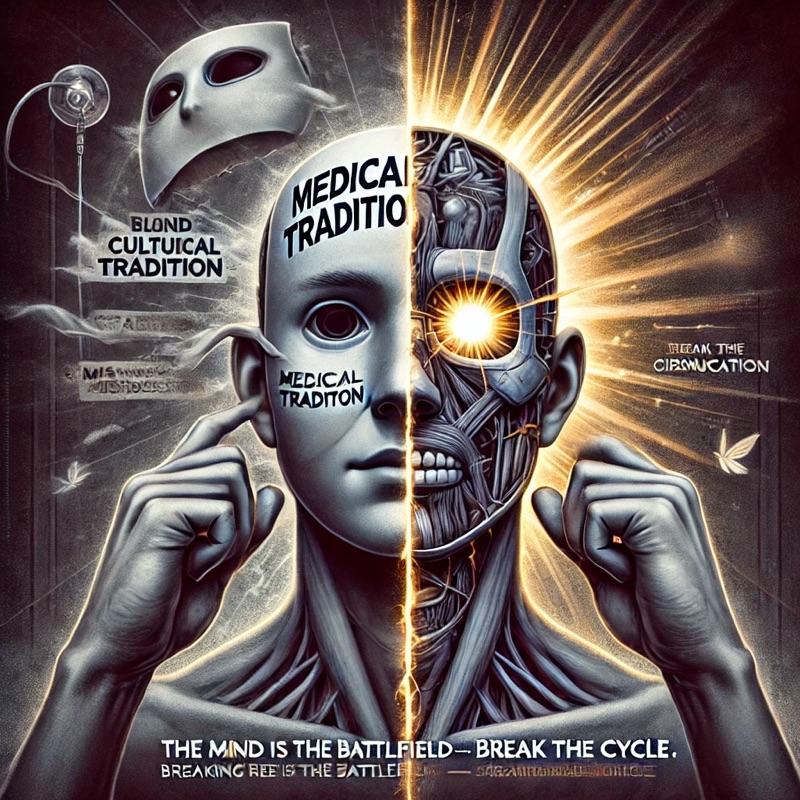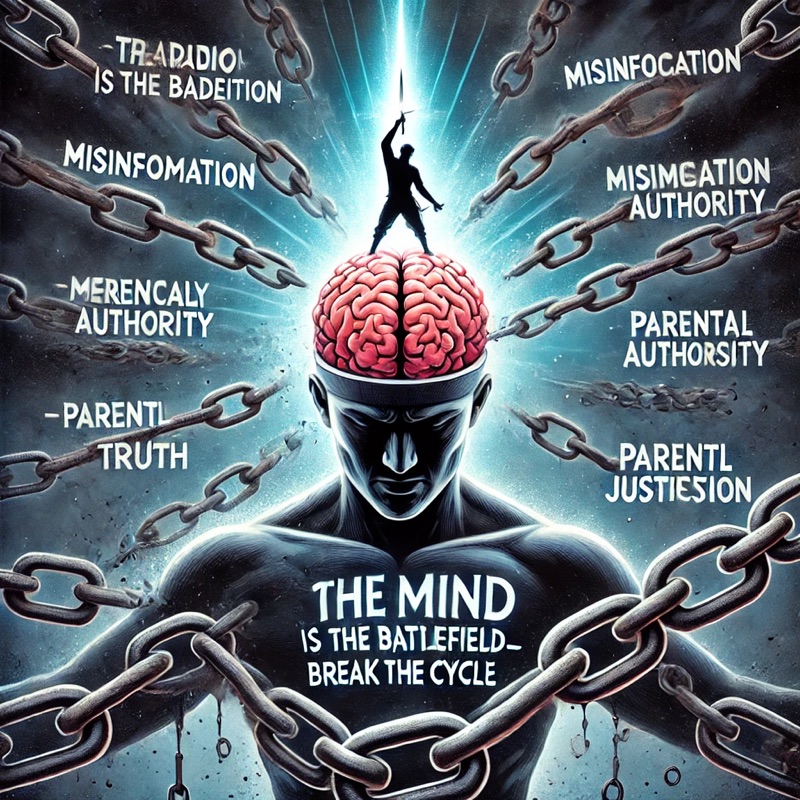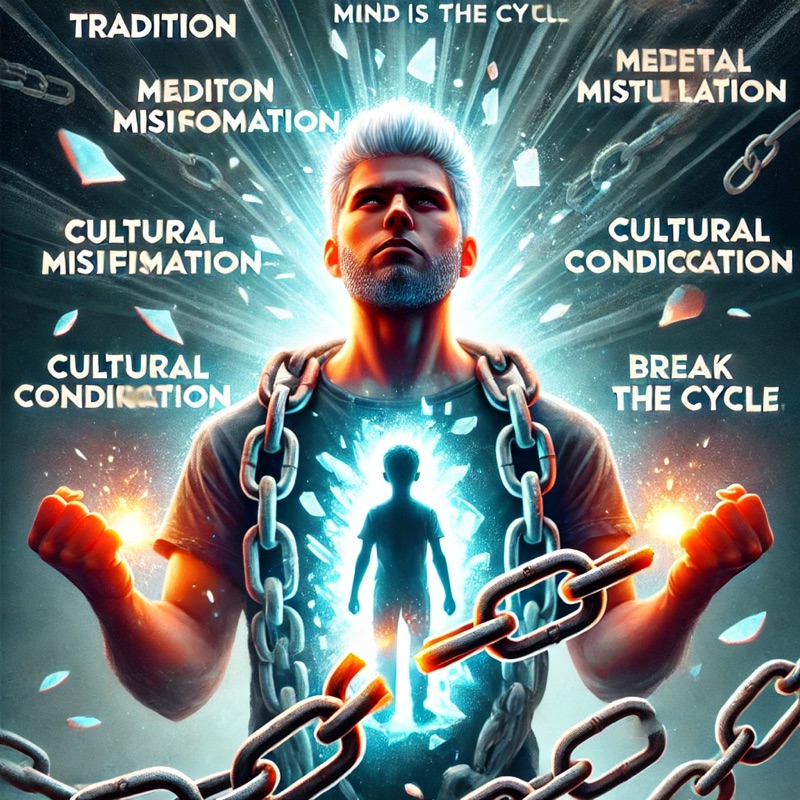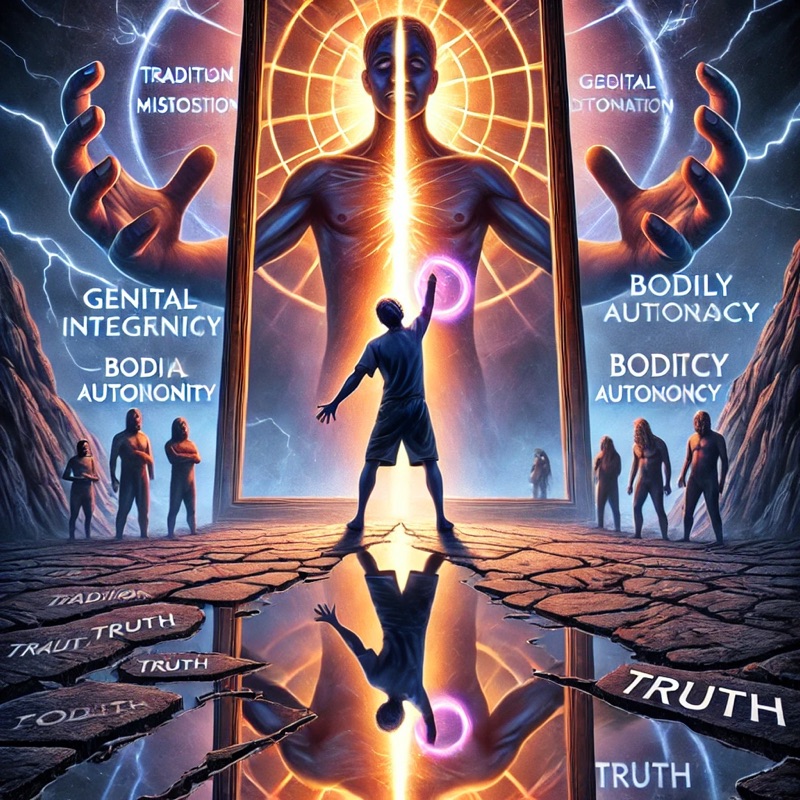The Psychological Battlefield of the Circumcision Debate: Defense Mechanisms, Cultural Programming, and Intactivist Strategy
The Psychological Battlefield of the Circumcision Debate: Defense Mechanisms, Cultural Programming, and Intactivist Strategy
Written By: ✌️💚🥑🍌 𝘼𝙫𝙤𝙘𝙖𝙙𝙤𝙅𝙖𝙮23 | 𝘼𝙙𝙫𝙤𝙘𝙖𝙩𝙞𝙣𝙜𝘼𝙫𝙤𝙘𝙖𝙙𝙤
Abstract
The circumcision debate is uniquely charged, deeply entrenched in cultural, medical, and psychological conditioning. Advocates for genital integrity frequently encounter cognitive dissonance, defense mechanisms, and emotional resistance from those invested in the practice. This paper examines the psychological warfare surrounding circumcision, exploring Cut Culture, common defense mechanisms, and the strategies needed for effective advocacy. It also outlines tactical responses for intactivists to navigate and dismantle these psychological barriers.
⸻
I. Introduction
Circumcision is one of the most polarizing bodily autonomy issues, largely because it is deeply tied to masculine identity, sexuality, parental authority, and cultural normalization. Unlike other debates on medical ethics, this issue uniquely triggers irrational hostility, emotional defensiveness, and deeply ingrained cognitive dissonance. Many people struggle to reconcile the reality of circumcision harm with their existing beliefs, leading them to defend the practice at all costs.
This paper will analyze:
• How cultural conditioning upholds circumcision despite medical and ethical evidence against it.
• The defense mechanisms people use to protect themselves from the discomfort of cognitive dissonance.
• The spectrum of resistance—how to identify who is open to discussion and who is not.
• The tactics used to silence intactivists and how to counteract them effectively.
• Psychological strategies for effective advocacy and emotional resilience.
By understanding the psychological battlefield, intactivists can become more strategic, resilient, and impactful in shifting the cultural narrative.
⸻
II. Understanding Cut Culture: A Framework for Psychological Analysis
What is Cut Culture?
“Cut Culture” refers to the social, medical, and psychological programming that normalizes circumcision. It functions as a self-sustaining system reinforced by generational conditioning, medical authority, and misinformation.
Key Aspects of Cut Culture
1. Parental Justification – “I did it to my son because it was done to me.”
2. Medical Normalization – “Doctors wouldn’t do it if it weren’t necessary.”
3. Masculine Identity Distortion – “A real man doesn’t need foreskin.”
4. Sexual Misinformation – “Women prefer it,” “It prevents STDs.”
5. The Myth of ‘Clean vs. Dirty’ – A stigma rooted in 19th-century hygiene fears.
Historical Parallels
Other harmful practices, such as foot binding, lobotomies, and forced sterilization, were once normalized using the same defense mechanisms seen in Cut Culture today.
Why does Cut Culture resist change? Because it is emotionally safer to believe a comforting lie than to confront an uncomfortable truth.
⸻
III. The Psychological Defense Mechanisms in the Circumcision Debate
When confronted with the reality of circumcision, many people instinctively deploy psychological defense mechanisms to protect themselves from cognitive dissonance. Below are the most common forms of resistance:
1. Cognitive Dissonance – The mental discomfort of realizing harm was done.
• Example: Fathers dismissing evidence because it threatens their identity.
2. Denial & Rationalization – “It’s just a little piece of skin,” “He won’t remember.”
3. Projection – Accusing intactivists of being “obsessed” while defending forced genital cutting.
4. Reaction Formation – Overcompensating—aggressively defending circumcision due to subconscious regret.
5. Stockholm Syndrome & Just-World Fallacy – Accepting circumcision as “what’s meant to be” to avoid facing trauma.
6. Deflection & False Equivalencies – “What about FGM?” or “What about vaccines?”
7. Gaslighting & Ridicule – The social silencing tactics used against intactivists.
These mechanisms reinforce cultural blind spots and prevent rational discussion.
⸻
IV. The Spectrum of Psychological Resistance: From Ignorance to Malicious Manipulation
Not everyone reacts to intactivism in the same way. Understanding where someone is on the spectrum of resistance helps intactivists tailor their approach.
1. Innocent Ignorance – Never questioned circumcision before; open to learning.
2. Mild Discomfort – Feels uneasy but still searching for justifications.
3. Active Defensiveness – Emotionally resistant, pushing back aggressively.
4. Hostile Entrenchment – Deeply invested in defending circumcision; uses manipulative tactics.
How to engage effectively:
• For ignorance and mild discomfort – Use facts, empathy, and open-ended questions.
• For active defensiveness – Challenge inconsistencies, but avoid triggering deeper entrenchment.
• For hostile entrenchment – Recognize when someone is a lost cause and disengage.
⸻
V. The Psychological Warfare Tactics Used Against Intactivists
People defending circumcision often use manipulative tactics to silence opposition. These include:
• Ridicule & Shaming – “Why are you obsessed with penises?”
• Appeal to Authority – “Doctors know best.”
• Strawman Attacks – Misrepresenting intactivist arguments.
• False Victimhood – “Parents are being attacked for their choice!”
• Misinformation Campaigns – Downplaying the functions of the foreskin.
How intactivists can counter these tactics:
1. Stay calm and assertive – Do not let emotional manipulation dictate the conversation.
2. Redirect the focus – Ask pointed, logical questions instead of getting defensive.
3. Leverage social proof – Use real-life testimonials and medical sources to shift perception.
⸻
VI. Effective Intactivist Strategies: Navigating Psychological Warfare
To win the psychological battle, intactivists must be strategic and mentally resilient.
Key Strategies:
1. Quick Perception & Pattern Recognition – Identify openness vs. bad-faith arguments.
2. Emotional Detachment & Resilience – Avoid burnout by recognizing when to disengage.
3. The Power of Questions – Use Socratic questioning instead of direct confrontation.
4. Breaking Down Cognitive Dissonance Gently – Allow people to come to realizations naturally.
5. Exposing Bad-Faith Debaters – Learn how to shut down deceptive tactics.
Example: Instead of saying, “Circumcision is genital mutilation,” ask, “If a baby girl had this done, would you still defend it?”
Let the question force cognitive dissonance rather than triggering immediate defensiveness.
⸻
VII. Conclusion: A Path to Breaking the Cycle
Cultural shifts take time, but understanding the psychology behind circumcision defense mechanisms allows intactivists to be more effective. By mastering quick perception, emotional resilience, and effective communication, we can disarm psychological barriers and gradually change public perception.
The circumcision debate is not just about the body—it is about the mind. Winning this battle requires not only facts, but also strategy, patience, and persistence.
With continued advocacy, the normalization of circumcision will fade—one mind at a time.
Frequently Asked Questions (FAQ)
1. Why do people defend circumcision so aggressively?
Circumcision is deeply tied to cultural identity, parental decisions, and masculinity. When confronted with evidence of harm, many people experience cognitive dissonance—a psychological discomfort that leads them to defend the practice instead of questioning it.
2. Isn’t circumcision just a personal or parental choice?
No, because the person affected—the child—does not consent. Parental rights do not extend to removing healthy, functional body parts from a non-consenting individual.
3. Doesn’t circumcision prevent infections and diseases?
No modern medical organization recommends routine infant circumcision. The foreskin is not a flaw—it is a natural, functional part of the male anatomy with protective, sensory, and immune functions. Basic hygiene is all that’s needed.
4. Why compare circumcision to female genital mutilation (FGM)?
Both involve forced genital cutting without consent. While they differ in severity, the core ethical issue remains: no one should have their genitals altered without consent.
5. How can I talk to someone about this without them getting defensive?
Use open-ended questions rather than making direct accusations. Example:
❌ “Circumcision is genital mutilation.”
✅ “If a baby girl had this done, would you still defend it?”
This forces cognitive dissonance without triggering instant defensiveness.
Enhancements for Stronger Impact
1. More Real-World Examples
• Brief case studies or testimonials can make the argument more personal and relatable:
• Example: A father who initially defended circumcision but later regretted it after learning the full truth.
• Example: Historical shifts in cultural norms—foot binding, lobotomies, and other harmful practices were also fiercely defended until society recognized the harm.
2. Expanded Tactical Advice for Intactivists
• Avoiding Burnout: Activism can be mentally exhausting—set boundaries, take breaks, and connect with like-minded advocates for support.
• Quick Responses to Common Attacks:
• “Why are you so obsessed with penises?” → “Why are you so obsessed with cutting them?”
• “Doctors know best.” → “Doctors once promoted lobotomies, thalidomide, and mercury treatments too. Medical authority is not infallible.”
• “Parents have the right to choose.” → “What other healthy body parts can parents legally remove from their child?”
3. Call to Action
• What can you do today?
• Share this article with others.
• Engage in respectful, strategic conversations—ask questions, plant seeds, and recognize when to disengage.
• Support organizations fighting for genital autonomy.
• Educate new parents before they fall into Cut Culture conditioning.
“The Mind is the Battlefield—Break the Cycle, End Cut Culture.”
Footnotes for “The Psychological Battlefield of the Circumcision Debate”
1. Cognitive Dissonance and Psychological Defense Mechanisms
• Festinger, L. (1957). A Theory of Cognitive Dissonance. Stanford University Press.
• Tavris, C., & Aronson, E. (2007). Mistakes Were Made (But Not by Me). Harcourt.
2. Cultural Conditioning and Cut Culture
• Darby, R., & Cox, L. (2008). A Painful Issue: Cultural Norms and the Persistence of Circumcision. Journal of Medical Ethics, 34(3), 258–263.
• Boyle, G. J., et al. (2002). Male Circumcision: Pain, Trauma, and Psychosexual Sequelae. Journal of Health Psychology, 7(3), 329–343.
3. Historical Parallels Between Circumcision and Other Harmful Practices
• Mackie, G. (1996). Ending Footbinding and Infibulation: A Convention Account. American Sociological Review, 61(6), 999–1017.
• Shorter, E. (1997). A History of Psychiatry: From the Era of the Asylum to the Age of Prozac. Wiley.
4. Medical and Ethical Criticism of Circumcision
• Frisch, M., et al. (2013). Cultural Bias in the AAP’s 2012 Technical Report and Policy Statement on Male Circumcision. Pediatrics, 131(4), 796–800.
• Svoboda, J. S., Van Howe, R. S., & Dwyer, J. (2000). Informed Consent for Neonatal Circumcision: An Ethical and Legal Conundrum. Journal of Contemporary Health Law & Policy, 17(1), 61–133.
5. Psychological Impact and Emotional Resistance to Intactivism
• Goldman, R. (1999). Circumcision: The Hidden Trauma. Vanguard Publications.
• Hammond, T. (1999). A Preliminary Poll of Men Circumcised in Infancy or Childhood. BJU International, 83(S1), 85–92.
6. Manipulative Tactics Used to Silence Intactivists
• Boyle, G. J., Goldman, R., Svoboda, J. S., & Fernandez, E. (2002). Male Circumcision: Pain, Trauma, and Psychosexual Sequelae. Journal of Health Psychology, 7(3), 329–343.
• Svoboda, J. S. (2016). Circumcision, Human Rights, and Ethical Considerations. The American Journal of Bioethics, 16(2), 59–71.
7. Strategies for Effective Intactivism
• McAllister, P. (2019). How to Win Any Argument: Mastering the Socratic Method. Arcturus Publishing.
• Chomsky, N. (1988). Manufacturing Consent: The Political Economy of the Mass Media. Pantheon Books.
#GenitalAutonomy #Intactivist #EndCutCulture #ForeskinFacts #HumanRights #StopGenitalMutilation #BodilyAutonomy #MedicalEthics #CircumcisionDebate #CognitiveDissonance #TruthOverTradition #IntactGeneration #ProtectChildren #QuestionEverything #MaleBodyIntegrity






📢 Want to Know the Truth?
👉 Watch Now: The Truth About Circumcision
Eric Clopper’s explosive, eye-opening presentation exposes the hidden truths about circumcision, its impact on men’s health, and the medical industry’s role in promoting it. If you care about bodily autonomy and human rights, this is a must-watch.
🔗 Sex & Circumcision: An American Love Story – Eric Clopper
🔗 https://youtu.be/FCuy163srRc?si=-I0uSf9MEV06bvY9
Comments
Post a Comment